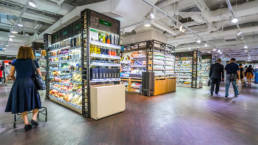ARTICLE
The Picking Series – The Future of Store Picking and the Fulfillment Mix
The grocery landscape is exploding with investment and opportunity. Grocery retailers who keep an eye on coming trends can make informed and confident decisions moving forward.

Prepare for tomorrow while succeeding today
Intelligent innovation heralds success in every industry. Grocers who’ve followed this series have learned a few things about maximizing available assets and taking advantage of current technology to perfect the shopper experience. These insights will positively serve their bottom line, but if grocery retailers don’t prepare for upcoming advancements in technology, the experienced success will be short-lived. Below we examine the future of store picking, which can be categorized into 3 frontiers: picking technology, product locations, and product data. We also answer the obvious question – “What about when store picking isn’t enough?”
Picking technology is the first frontier as many new technologies are currently being developed or re-tooled for grocery. Wearable devices in particular are at the forefront of discussion. Pioneered and tested by other industries, the wearable space is already mature. The purpose of wearable devices can be diverse, and some devices track picker performance while others are directly involved with item selection. For example, ring-mounted scanners that can free up both hands for the picker. Some grocers already introduced wearable enhancement technology like lifting exo-suits for dedicated workers that pick all day. With such broad potential, retailers who take advantage of the insights gathered on wearables in other markets will minimize missteps.
Beyond wearables, the two most compelling challengers are pick-by-light systems and voice-directed systems. Pick-by-light is any system that incorporates light to guide pickers to the items they should be selecting. Visual cues can include different colors, letters, and numbers to speed up the item selection process. Voice-directed systems are similar, with the distinction of swapping out light for audio guidance. Voice picking differs from pick-by-light in item selection, as some setups will include voice recognition technology to interact with the picker selection process. Each system has its merits. Voice picking is more cost-effective in large warehouses while light picking is generally favored for less dense, strictly zoned picking environments. Both systems are attempting to maximize nonautomated picking performance by relying on faster information delivery than is currently available.
The second frontier is product location data & sequencing. Typically, product location data is limited to aisle-by-aisle reporting. Expanding data to account for granular product location (shelf position/shelf section) will allow grocers to guide pickers with pinpoint accuracy. Systems that go a step further and incorporate product coordinates can take pick path optimization to an entirely new level. Dynamic sequencing will be much more efficient than sequencing done linearly by aisle.
Grocers will gain much more than improved picking options from deploying advanced measurement tactics on their inventory. We previously discussed the value of product availability and how e-commerce technology revolutionized retailers’ ability to track their products. Implementing automated solutions like computer vision tracking or robotic solutions will increase control over product availability even further. Grocers can use this information to boost customer satisfaction rates and decrease shrink. They should also utilize increased inventory visibility to support new in-store operations like frictionless checkout.
Location isn’t the only relevant product data for retailers to invest in. Item dimension data, or “volumetric data,” is the third frontier for in-store picking. This data type includes height, weight, and the shapes of items. Understanding the volumetric data of products will drive fulfillment efficiency, specifically in the item consolidation section of the process. Once the information exists, machine learning algorithms can begin optimizing product combinations to create the best item totes. This grocery tetris will eliminate wasted space in totes, reducing the overall totes that have to be picked and fulfilled.
New technology and data advancements are shaping the future grocery retailers will see in their stores. But what’s beyond the store? Where do grocers go when in-store picking can’t get the job done? The typical answers include Micro Fulfillment Centers, full-sized Fulfillment Warehouses, and Dark Stores. Automation also gets thrown around a lot. These solutions aren’t new, and plenty of retailers have experimented with them. Retailers have understood for a while that sometimes advanced infrastructure has to be created to support e-commerce operations. A fresher perspective based on understanding gained in the past two years is that optimizing current assets should come before intensive capital investments in MFCs or other stand-alone solutions.
The answer to the previous question is a theme that has appeared throughout most of this series: grocers should identify the solution that best matches their needs, and build around that. An expanded fulfillment-first investment doesn’t nullify in-store operations. That’s why we call it the “fulfillment mix”. Retailers should plan to operationally integrate their new warehouse or system capabilities with their store assets. They are not maximizing ROI if they neglect this integration.
As grocery retailers solidify their plans for e-commerce over the next half decade and beyond, they need to understand all of the changes on the horizon. With exciting opportunities at every turn, it’s easy to be swayed by each compelling trend the market will see. Importantly, flashy systems and “more data” have never won market share on their own. The grocers who focus on implementing these technologies purposefully and with measured operational adjustments will win tomorrow’s wallet wars. The grocers who start planning to do so now can win those wars today.
The Picking Series #1

Store Productivity
Profitability hinges on efficiency. Understanding the store from a fulfillment perspective can help retailers quickly maximize operational outputs at low costs.
The Picking Series #2

Product Availability
High product availability drives brand loyalty and sales. Grocers should seize the opportunity offered by e-commerce technology to track and improve availability across all channels.


